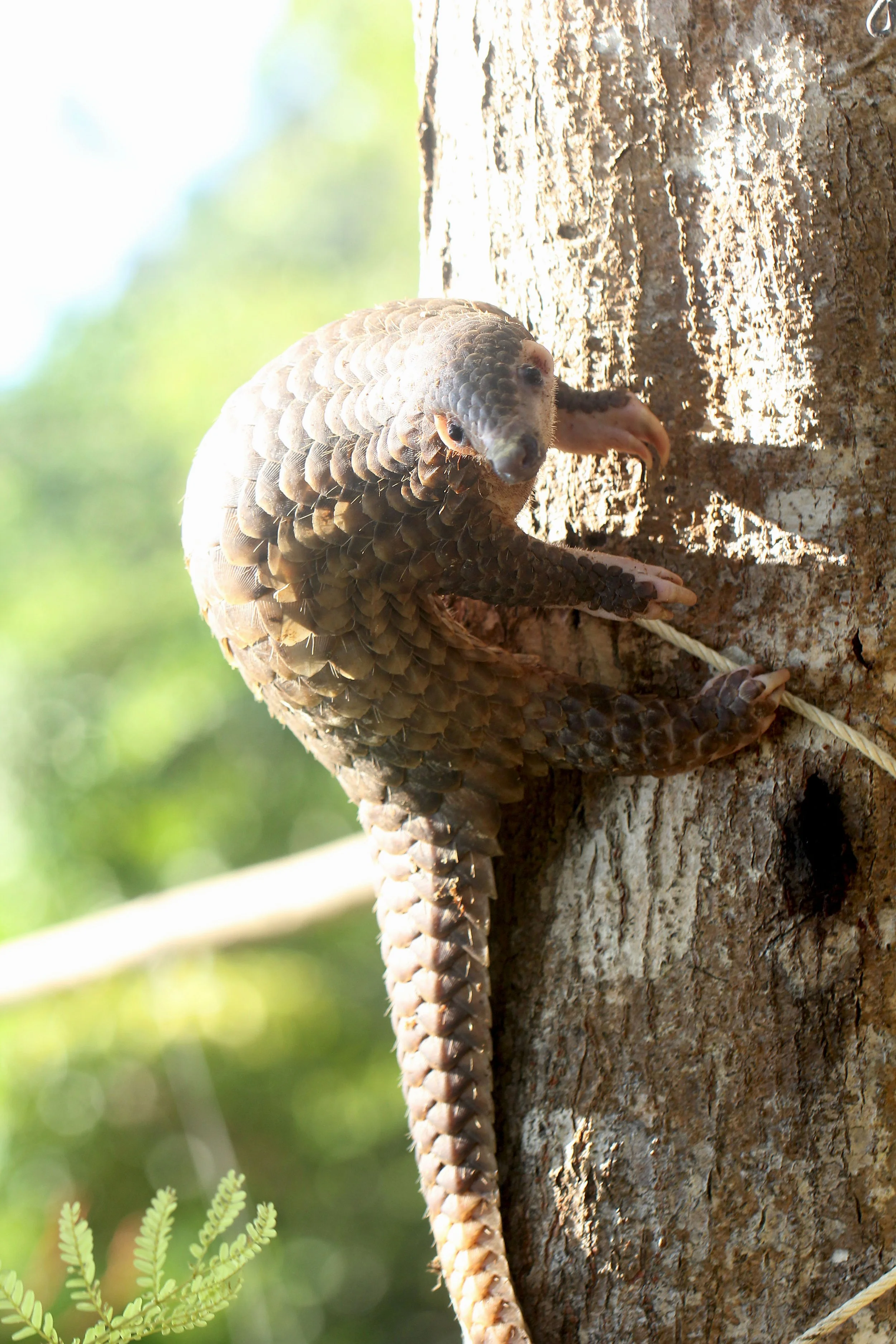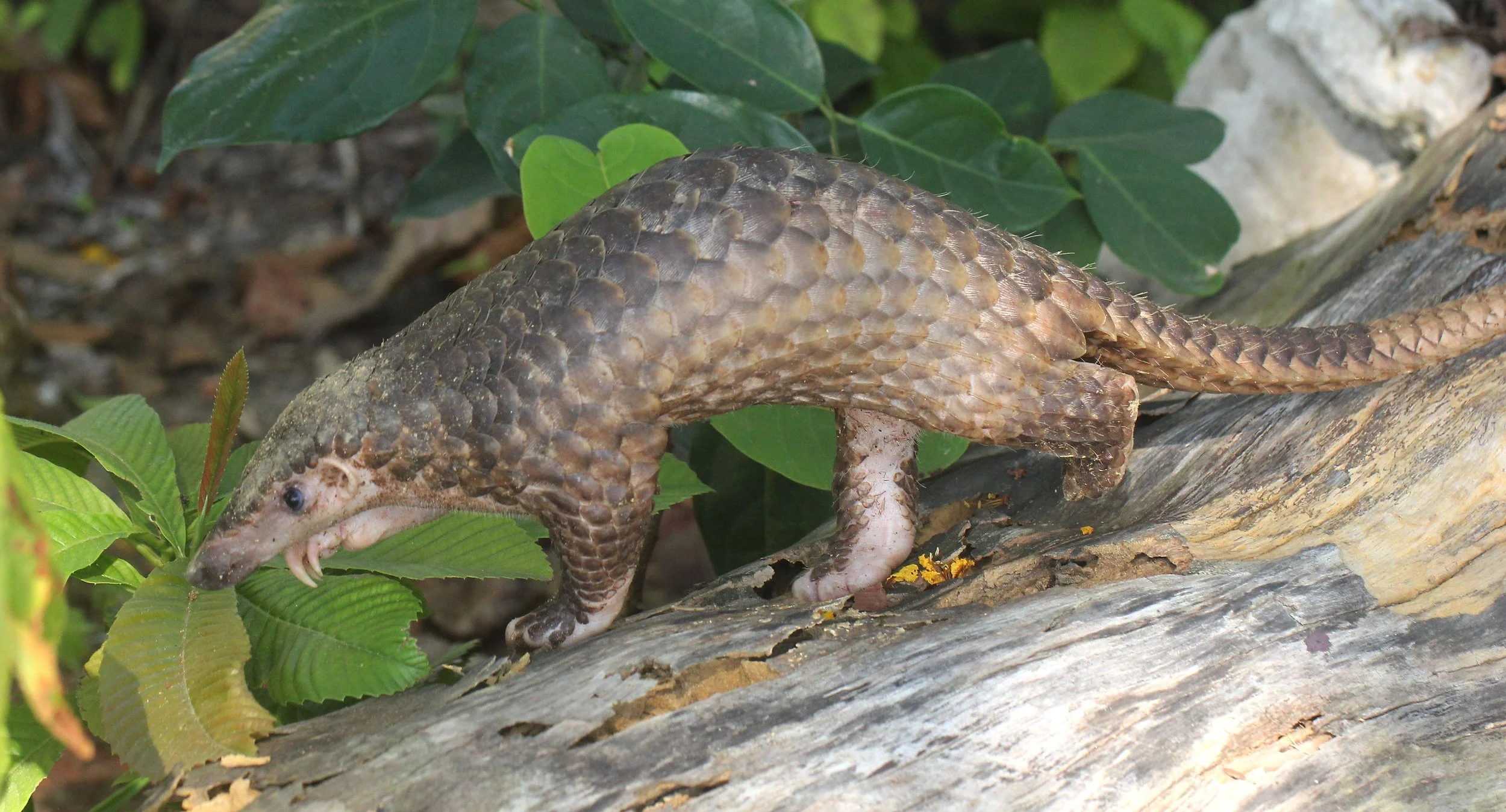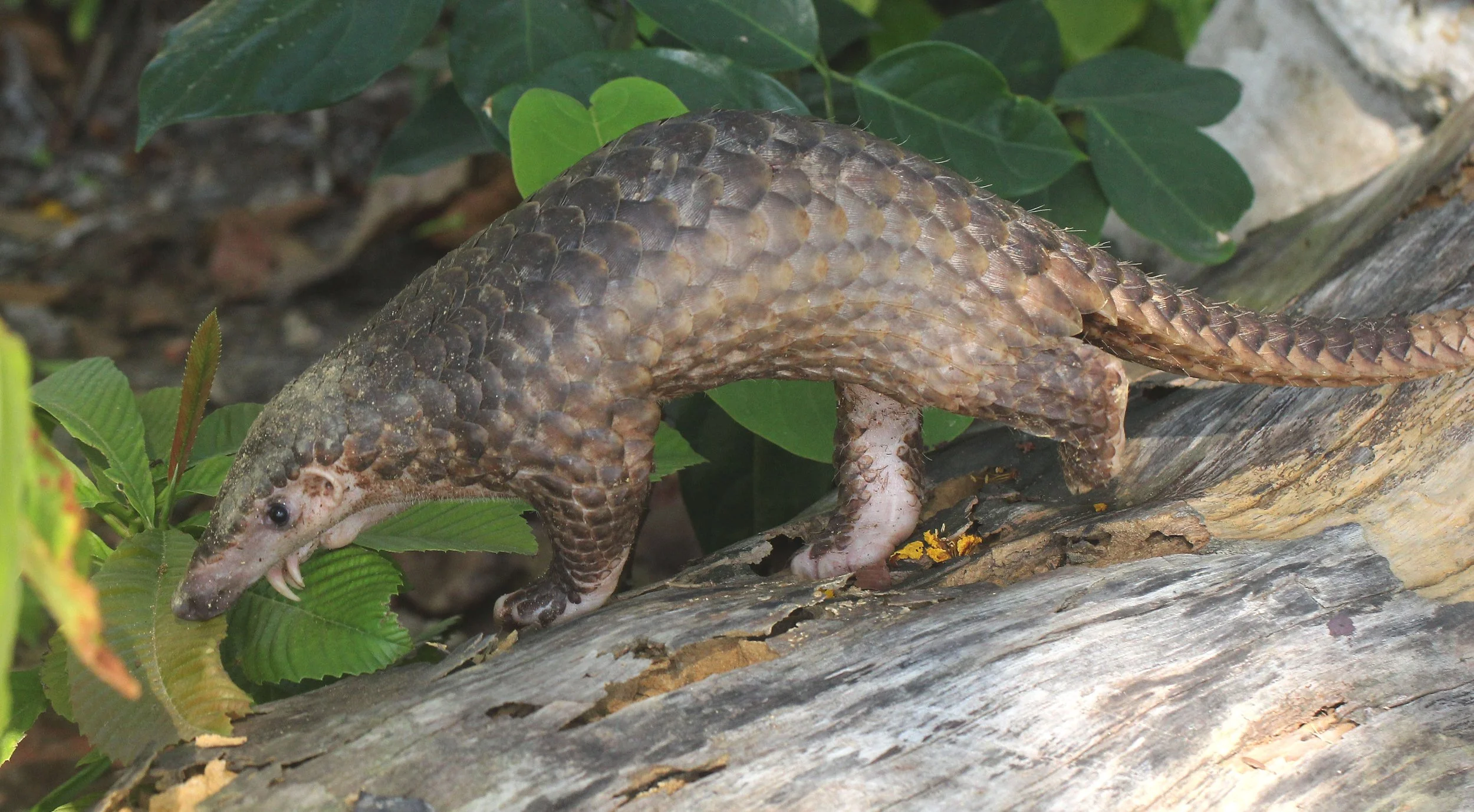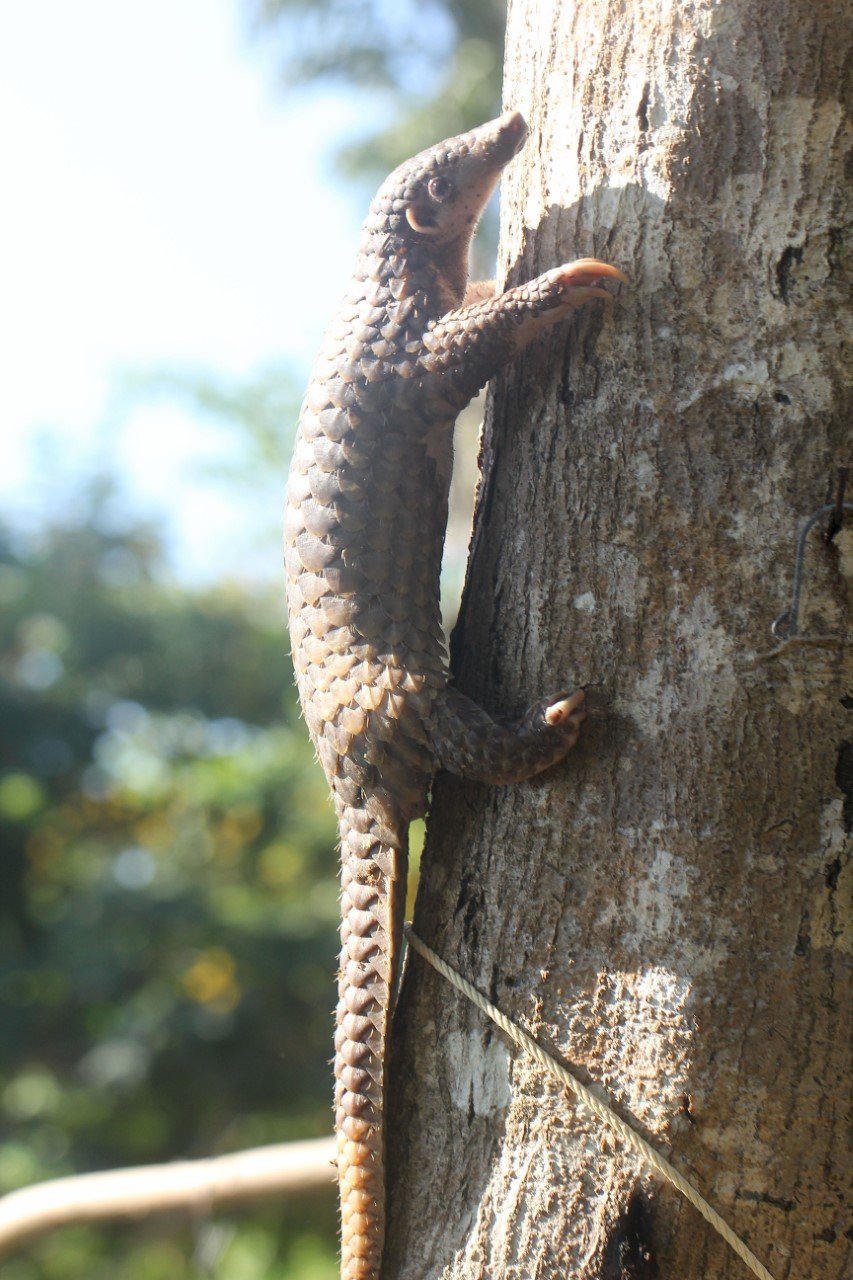
Pangolins
In this Gallery
Tree Pangolin
Sunda Pangolin
White-tailed Pangolin
Indian Pangolin
Pangolins, sometimes known as scaly anteaters, are mammals of the order Pholidota (Ancient Greek - "clad in scales"). The one extant family, the Manidae, has three genera: Manis, Phataginus, and Smutsia. Manis comprises the four species found in Asia, while Phataginus and Smutsia include two species each, all found in sub-Saharan Africa. These species range in size from 30 to 100 cm (12 to 39 in). A number of extinct pangolin species are also known.
Pangolins have large, protective keratin scales, similar in material to fingernails and toenails, covering their skin; they are the only known mammals with this feature. They live in hollow trees or burrows, depending on the species. Pangolins are nocturnal, and their diet consists of mainly ants and termites, which they capture using their long tongues. They tend to be solitary animals, meeting only to mate and produce a litter of one to three offspring, which they raise for about two years.
Pangolins are threatened by poaching (for their meat and scales, which are used in traditional medicine) and heavy deforestation of their natural habitats, and they are the most trafficked mammals in the world. As of January 2020, there are eight species of pangolin whose conservation status is listed in the threatened tier. Three (Manis culionensis, M. pentadactyla and M. javanica) are critically endangered, three (Phataginus tricuspis, Manis crassicaudata and Smutsia gigantea) are endangered and two (Phataginus tetradactyla and Smutsia temminckii) are vulnerable on the Red List of Threatened Species of the International Union for Conservation of Nature.
The physical appearance of a pangolin is marked by large, hardened, overlapping, plate-like scales, which are soft on newborn pangolins, but harden as the animal matures. They are made of keratin, the same material from which human fingernails and tetrapod claws are made, and are structurally and compositionally very different from the scales of reptiles. The pangolin's scaled body is comparable in appearance to a pine cone. It can curl up into a ball when threatened, with its overlapping scales acting as armor, while it protects its face by tucking it under its tail. The scales are sharp, providing extra defense from predators.
Pangolins can emit a noxious-smelling chemical from glands near the anus, similar to the spray of a skunk. They have short legs, with sharp claws which they use for burrowing into ant and termite mounds and for climbing.
The tongues of pangolins are extremely long, and like those of the giant anteater and the tube-lipped nectar bat, the root of the tongue is not attached to the hyoid bone, but is in the thorax between the sternum and the trachea. Large pangolins can extend their tongues as much as 40 cm (16 in), with a diameter of only about 0.5 cm (1⁄5 in).
Sunda Pangolin in my garder in Koh Lanta, Thailand.
Most pangolins are nocturnal animals[21] which use their well-developed sense of smell to find insects. The long-tailed pangolin is also active by day, while other species of pangolins spend most of the daytime sleeping, curled up into a ball ("volvation").
Arboreal pangolins live in hollow trees, whereas the ground-dwelling species dig tunnels to a depth of 3.5 m (11 ft).
Some pangolins walk with their front claws bent under the foot pad, although they use the entire foot pad on their rear limbs. Furthermore, some exhibit a bipedal stance for some behaviour, and may walk a few steps bipedally. Pangolins are also good swimmers.
Pangolins are insectivorous. Most of their diet consists of various species of ants and termites, and may be supplemented by other insects, especially larvae. They are somewhat particular and tend to consume only one or two species of insects, even when many species are available to them. A pangolin can consume 140 to 200 g (5 to 7 oz) of insects per day. Pangolins are an important regulator of termite populations in their natural habitats.
Pangolins have very poor vision. They also lack teeth. They rely heavily on smell and hearing, and they have other physical characteristics to help them eat ants and termites. Their skeletal structure is sturdy and they have strong front legs that are used for tearing into termite mounds. They use their powerful front claws to dig into trees, soil, and vegetation to find prey, then proceed to use their long tongues to probe inside the insect tunnels and to retrieve their prey.
The structure of their tongue and stomach is key to aiding pangolins in obtaining and digesting insects. Their saliva is sticky, causing ants and termites to stick to their long tongues when they are hunting through insect tunnels. Without teeth, pangolins also lack the ability to chew; but while foraging, they ingest small stones (gastroliths), which accumulate in their stomachs to help to grind up ants. This part of their stomach is called the gizzard, and it is also covered in keratinous spines. These spines further aid in the grinding up and digestion of the pangolin's prey.
Sunda Pangolin (Manis javanica)
The Sunda pangolin (Manis javanica), also known as the Malayan or Javan pangolin, is a species of pangolin.
It is found throughout Southeast Asia, including Myanmar, Thailand, Cambodia, Laos, Malaysia, Singapore, Vietnam, and the islands of Borneo, Java, Sumatra and the Lesser Sunda Islands. It prefers forested habitats (primary, secondary, and scrub forest) and plantations (rubber, palm oil). A large part of its life is spent in trees.
The below individuals are wild and located in Koh Lanta, Southern Thailand Krabi Province.








































































Tree Pangolin (Phataginus tricuspis)
The Tree Pangolin (Phataginus tricuspis) is one of eight extant species of pangolins ("scaly anteaters"), and is native to equatorial Africa. Also known as the white-bellied pangolin or three-cusped pangolin, it is the most common of the African forest pangolins.
Phataginus tricuspis is a relatively small pangolin. The combined head and body length is 33–43 cm (13–17 in). The tail is 49–62 cm (19–24 in). Each scale has three points, to which the specific name tricuspis refers. The head is small, and the snout is elongated. The feet are short, and each foot has five long curved claws.
The tree pangolin had belonged to the genus Manis and subgenus Phataginus before Phataginus was elevated to generic status. Two subspecies were recognized in 1972 by Meester:
P. t. tricuspis
P. t. mabirae
The tree pangolin ranges from Guinea through Sierra Leone and much of West Africa to Central Africa as far east as extreme southwestern Kenya and northwestern Tanzania. To the south, it extends to northern Angola and northwestern Zambia. It has been found on the Atlantic island of Bioko, but no records confirm a presence in Senegal, Gambia, or Guinea-Bissau.
The tree pangolin is semiarboreal and generally nocturnal. It is found in lowland tropical moist forests (both primary and secondary), as well as savanna/forest mosaics. It probably adapts to some degree to habitat modification, as it favours cultivated and fallow land where it is not aggressively hunted (e.g., abandoned or little-used oil palm trees in secondary growth).
White-bellied Tree Pangolin (Phataginus tricuspis) Dzangha Ndoki National Park, Central African Republic




Long-tailed Pangolin (Phataginus tetradactyla)
The Long-tailed Pangolin (Phataginus tetradactyla), also called the African black-bellied pangolin, is a diurnal, arboreal pangolin species belonging to the family Manidae, in the order Pholidota. They feed on ants rather than termites. The common names for this species stem from physical characteristics, such as the extremely long tail or the dark hairs that cover the underside of their bodies and limbs. Pangolin comes from the Malay word pengguling, meaning “something that rolls up”.
Phataginus tetradactyla has a characteristic very long tail (hence its common name), reaching a length around 60–70 cm (24–28 in). The tail contains 46–47 caudal vertebrae, a record among mammals. The body can reach a length of 30–40 cm (12–16 in) and weigh 2.0–2.5 kg. The males are larger than the females.
Even with the long tail, this species is the smallest of eight extant species of pangolins. As with other pangolins, the long-tailed pangolin is covered with 9 to 13 rows of overlapping, artichoke leaf-shaped keratinous scales. The scales are dark brown color with a brighter rim, which serves as camouflage. The feet have large, curved claws. The tip of the tail is bare and contains a sensory pad that allows the individual to seek out and grip branches. They do not have teeth, while the tongue is very long. The abdomen, underside of the limbs, and face are covered in dark fur instead of scales.
The long-tailed pangolin is the only diurnal pangolin species.
Native to parts of western and central Africa, the long tailed-pangolin has been found as far west and north as Senegal, across the continent to Uganda, and south into Angola. They are found in areas such as the Congo Basin and Guinean forests. A distinct gap in populations has been observed starting in southwest Ghana, with no record of individuals found through to western Nigeria.
Long-tailed pangolins are found in moist, tropical riverine and swamp forest environments, but have been observed in altered forests (bush), and agricultural areas of former lowland rain forests. They are almost exclusively arboreal, spending the majority of their time in the canopy region. They prefer to live in the interior part of the forests, avoiding the outermost edges. They are capable swimmers, and are usually found near water.
Long-tailed Pangolin (Phataginus tetradactyla) Bush meat for sale along the road to Dzangha Ndoki National Park, Central African Republic. This individual was still alive unfortunately.






Indian Pangolin (Manis crassicaudata)
The Indian Pangolin (Manis crassicaudata), also called thick-tailed pangolin and scaly anteater is a pangolin native to the Indian subcontinent. Like other pangolins, it has large, overlapping scales on its body which act as armour. The colour of its scales varies depending on the colour of the earth in its surroundings. It can also curl itself into a ball as self-defence against predators such as the tiger. It is an insectivore feeding on ants and termites, digging them out of mounds and logs using its long claws, which are as long as its fore limbs. It is nocturnal and rests in deep burrows during the day.
Plenty of tracks of the Indian Pangolin in Udawalawa National Park in Sri Lanka
It is not common anywhere in its range, and is threatened by hunting for its meat and for various body parts used in traditional medicine.
The Indian pangolin is a solitary, shy, slow-moving, nocturnal mammal.[3] It is about 84–122 cm (33–48 in) long from head to tail, the tail usually being 33–47 cm (13–19 in) long, and weighs 10–16 kg (22–35 lb). Females are generally smaller than the males and have one pair of mammae. The pangolin possesses a cone-shaped head with small, dark eyes, and a long muzzle with a nose pad similar in color, or darker than, its pinkish-brown skin. It has powerful limbs, tipped with sharp, clawed digits.[3] The pangolin has no teeth, but has strong stomach muscles to aid in digestion.[3] The most noticeable characteristic of the pangolin is its massive, scaled armour, which covers its upper face and its whole body with the exception of the belly and the inside of the legs. These protective scales are rigid and made of keratin. It has 160–200 scales in total, about 40–46% of which are located on the tail. Scales are 6.5–7 cm (2.6–2.8 in) long, 8.5 cm (3.3 in) wide, and weigh 7–10 g (0.25–0.35 oz). The skin and scales make up about one-fourth to one-third of the total body mass of this species.
The Indian pangolin has been recorded in various forest types, including Sri Lankan rainforest and plains to middle hill levels. It inhabits grasslands and secondary forests, and is well adapted to dry areas and desert regions, but prefers more barren, hilly regions. In Sri Lanka, it was sighted at an elevation of 1,100 m (3,600 ft), and in the Nilgiri mountains at 2,300 m (7,500 ft). It prefers soft and semi-sandy soil conditions suitable for digging burrows.
The following images are tracks of the Indian Pangolin in Udawalawa National Park, Sri Lanka:















